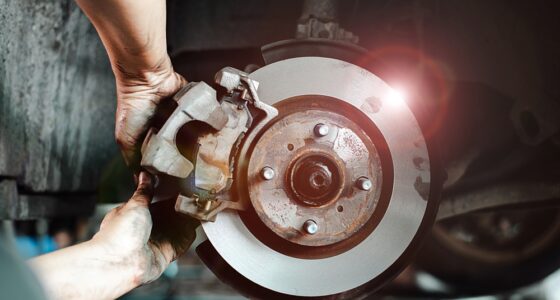In the long list of items blamed for exposing people to asbestos, brakes, brake pads, and brake linings are among those that impacted the widest range of people. In addition to occupational exposure among mechanics, many hobbyists also suffered asbestos exposure through brake components. Both people who worked on brakes in the past and those working on them today may be at risk for malignant mesothelioma, asbestos-related lung cancer, and other asbestos-related diseases.

The History of Asbestos Brakes
Whether on cars, trucks, planes, or trains, the braking system is the most important safety system on any vehicle. Brakes help bring the vehicle to a complete stop by slowing down the rotation of the wheels when the brake pedal or other braking mechanism is engaged.
Brakes have been a part of transportation ever since man began hitching wagons to animals. The original brake system was nothing more than a wooden block that pressed against wheels when the driver pulled a lever, and even when mechanized vehicles were introduced, the wooden block continued to be used.
However, as cars began to exceed speeds of 10 or 20 miles per hour and wooden tires were replaced with rubber, innovation became necessary. In 1901, Herbert Frood of Derbyshire, England, received a patent for the first commercial brake pads, which he called Brake Blocks. They were made from layers of cotton cloth filled with resin, camel hair, leather, and wood.[1]
In 1902, the disc brake, consisting of a caliper that pressed brake pads against a steel disc, was invented. The device created friction to stop the vehicle, but the brake linings wore down quickly and created a terrible noise when pressed against the steel disc.[2]
By 1908, Frood came up with a solution by lining brake pads with asbestos. Asbestos is known for its durability and heat resistance. His invention led to the widespread use of asbestos as a friction material and the founding of a company called Ferodo that still manufactures brakes today.
Ferodo was purchased by Turner & Newell and continued developing brake friction material through much of the twentieth century. In the 1930s, the brakes were made with molded instead of woven linings, and other fibers were introduced. Asbestos continued to be used as the base material in brakes until the cancer-causing properties became known, and its use was abandoned.[1]
Where Were Asbestos Brakes Used?
Asbestos was primarily found in:
- Brakes, brake pads, brake linings, brake drums, and disc brake systems in automobiles, including cars, buses, trucks, and trains
- Heavy machinery, such as cranes, airplanes, and helicopters, as well as in freight cars and railroad locomotives, and in specialized military equipment, including tanks.
- Anchor and propeller systems. Its friction-resistant properties made it ideal for all of these applications
What Were the Dangers of Asbestos Brakes?
Asbestos fibers combined with phenolic resins accounted for 20 to 40% of brake liners. They provided mechanical strength, reinforced the brake pad, and accounted for between 6 and 35% of the brake mass in most cases. In some cases, asbestos content was much higher.
Asbestos provided tensile strength and the capacity to withstand heat. As a fibrous mineral, asbestos could easily break down into easily inhaled particles during the process of installing or repairing brake systems.[3]
When friction pads are fit during automotive repairs, the leading edge of the brake pad is generally beveled to produce smoother interaction between the brake and the opposing metal surface.
Similarly, the replacement of brake pads on heavy-duty vehicles and industrial equipment frequently involved drilling the pads so that they could be attached to the brake shoe or backing plate. This procedure released fine debris made up of asbestos fibers.
The Department of Health, Education, and Welfare, in conjunction with the Centers for Disease Control and Prevention and the National Institute for Occupational Safety and Health (NIOSH), issued a warning in 1975, noting the significant danger posed to workers engaged in maintaining and repairing auto and truck brake linings.
Other early studies found asbestos diseases in mechanics who worked on brake systems. These studies concluded that all brake maintenance workers are at risk for asbestos exposure and resulting illnesses.[4]
Illnesses Caused by Exposure to Asbestos Brakes
Asbestos is a known carcinogen that has been linked to several serious illnesses, including:
- Malignant mesothelioma. This rare and deadly form of cancer forms when asbestos fibers become embedded in the lining of the pleural or peritoneal cavity, causing cell death, mutation, and the growth of tumors. The disease is always considered fatal.
- Asbestos-related lung cancer. A form of lung cancer specifically caused by asbestos exposure. The inflammation and cell death caused by the carcinogenic particles being embedded in cells lead to the growth of malignant tumors inside the lungs.
- Pleural plaques. A scarring of the membrane surrounding the lungs. Frequently appears before the development of mesothelioma, asbestos-related lung cancer, and asbestosis.
- Asbestosis. A scarring of the lung tissue is caused by inhaling asbestos fibers. It causes chronic cough, shortness of breath, and a higher risk of lung diseases, infections, and pneumonia.
- Chronic Obstructive Pulmonary Disease (COPD). COPD is an umbrella term describing several irreversible lung diseases, including emphysema and chronic bronchitis. Symptoms include wheezing, shortness of breath, and chronic cough.
Malignant mesothelioma and other asbestos-related illnesses have extremely long latency periods. This means they can take years before symptoms begin to appear. Because these diseases are so rare, many physicians are unfamiliar with their symptoms and misdiagnose them as more benign conditions.
This delay in diagnosis can have a significant negative impact as the aggressive diseases continue to progress. Early diagnosis and appropriate treatment deliver the greatest chance of longer survival and better outcomes.
Who Is at Risk for Exposure to Asbestos Brakes
Asbestos brakes have been used in a wide range of military and civilian occupational settings. Those most at risk of occupational exposure include:
- Aircraft mechanics
- Auto mechanics
- Auto parts store employees
- Brake shop mechanics
- Brake factory workers
- Railroad brake mechanics
- Veterans
Additionally, hobbyists who performed brake repairs on their own purchased asbestos-containing brakes from retail auto parts stores and were exposed to asbestos through the work they did in their home garages.
There was also a significant risk of secondary asbestos exposure posed to wives, children, and other family members of all those who worked directly with the brakes.
Any airborne asbestos fibers that settled on these individuals’ hair, skin, and clothing could be carried into their homes or into the family automobile, where they could be inhaled or ingested.
Companies that Manufactured Asbestos Brakes
Dozens of companies manufactured, sold, and distributed asbestos brakes:
- Advance Auto Parts
- Akebono Brake Industry Co., Ltd
- Allied Signal, Inc./Bendix Corporation
- Arnold Industries
- Carlisle Industrial Brake & Friction
- Caterpillar, Inc.
- Chrysler
- Ferodo
- Ford Motor Co.
- John Deere Industrial Equipment Co.
- Johns Manville
- Kelsey-Hayes Company
- Montgomery Ward and Co.
- National Friction Products Corp.
- North American Rockwell Corp.
- Pep Boys
- Raybestos/Raymark Industries
- Union Tank Car Company
Many of these companies have been named in personal injury lawsuits filed by or on behalf of individuals who have been sickened or killed by exposure to asbestos in their products.
Asbestos Brake Lawsuits
There have been many people who’ve been sickened by asbestos-containing brake pads, brake linings, and brake systems, and many of them have resulted in significant verdicts for the victims and their family members. A few notable claims include:
- After Roy Barbarino worked for the New York City Transit Authority from 1962 to 1987, he was diagnosed with malignant mesothelioma. His job responsibilities included maintaining, inspecting, and repairing vehicles, and he was constantly exposed to workers performing brake repairs. After his death, his family filed a personal injury lawsuit against Honeywell International, blaming the asbestos in the company’s Bendix brakes for his fatal illness. The case is still pending.
- Gordon Bankhead, a mechanic who worked on vehicles containing Pneumo-Abex asbestos brake pads, was diagnosed with mesothelioma and sued the company in 2010. A jury awarded him $4 million in compensation. When Mr. Bankhead died a year later, his family filed a wrongful death lawsuit and won $11 million.
- A former auto mechanic diagnosed with terminal mesothelioma after years of working with asbestos-containing brakes filed a lawsuit against Pneumo Abex LLC and Ford Motor Company. A Miami, Florida, jury awarded his survivors $37 million in damages.
Can You Still Be Exposed to Asbestos from Brakes?
Though brakes and clutches installed in new and recent model vehicles do not contain asbestos, many mechanics and do-it-yourselfers are exposed to asbestos in previously installed brakes and replacement brakes that may have been sitting in inventories for decades. There is also a significant risk from brake parts that are manufactured and imported from overseas.
To protect workers from exposure to asbestos-containing brakes, the Occupational Safety and Health Administration has issued a bulletin about asbestos-automotive brake and clutch repair work meant to guide the safe use of these products. The bulletin’s instructions include:[5]
- Work in an environment equipped with a negative-pressure enclosure/HEPA vacuum system. This system encloses the assembly to prevent the release of asbestos fibers during brake or clutch inspection, seals the enclosure, and uses a HEPA-filtered vacuum to keep the enclosure under negative pressure both to loosen asbestos residue from the parts and then to evacuate the loosened material into a vacuum filter. When the filter is full, it needs to be sprayed with a fine mist of water.
- Facilities that inspect, disassemble, reassemble, and/or repair five or fewer brake or clutch jobs per week are advised to use a pressure/wet cleaning method that involves positioning a catch basin under the brake assembly, flooding it with water or a wetting agent to prevent asbestos-containing brake dust from becoming airborne, washing the various brake parts, and the cleaning all spills and containing asbestos-containing liquids in an impermeable container to be labeled and disposed of as asbestos waste.
If you are a hobbyist working with older cars, always assume the brakes have asbestos and proceed with caution.
Were You Exposed to Asbestos Brakes?
If you were exposed to asbestos-containing brakes during your career, to asbestos carried home by a loved one who worked with them, or while performing home or auto repairs, you may be at risk for asbestos-related illnesses.
Even if you feel healthy now, it’s crucial to make sure you’re familiar with the symptoms of asbestos-related diseases so you can react quickly should any arise. Additionally, inform your physician about your history of asbestos exposure so that they will consider asbestos-related illnesses when evaluating any future symptoms.
If you’re diagnosed with malignant mesothelioma or any other asbestos-related illness after working with asbestos-containing brakes, you have several options.
You can file a personal injury lawsuit seeking compensation for your expenses, pain, and suffering; this will ensure your family’s economic security in the future.
To learn more about this and other options, contact an asbestos attorney. These experienced, knowledgeable professionals will listen to your concerns and answer all your questions. They’ll explain the process and the possibilities.
This may include applying for veterans’ benefits if your exposure came during military service or filing a claim with an asbestos bankruptcy trust if your exposure is linked to any companies that have filed for bankruptcy. Asbestos-related diseases are devastating, but you do have options.

Terri Heimann Oppenheimer
WriterTerri Oppenheimer has been writing about mesothelioma and asbestos topics for over ten years. She has a degree in English from the College of William and Mary. Terri’s experience as the head writer of our Mesothelioma.net news blog gives her a wealth of knowledge which she brings to all Mesothelioma.net articles she authors.

Dave Foster
Page EditorDave has been a mesothelioma Patient Advocate for over 10 years. He consistently attends all major national and international mesothelioma meetings. In doing so, he is able to stay on top of the latest treatments, clinical trials, and research results. He also personally meets with mesothelioma patients and their families and connects them with the best medical specialists and legal representatives available.
References
- Carney, J. (2021, May 26). Vehicle Brake Pads History. Goodyear Brakes.
Retrieved from: https://goodyearbrakes.com/brake-pads/material/vehicle-brake-pads-history/ - Carney, J. (2021, June 23). Brake Rotors | Brake Discs History. Goodyear Brakes.
Retrieved from: https://goodyearbrakes.com/rotors/fundamentals-rotors/brake-rotors-discs-history/ - United States Environmental Protection Agency. (2024, October 15). Current Best Practices for Preventing Asbestos Exposure Among Brake and Clutch Repair Workers.
Retrieved from: https://www.epa.gov/asbestos/current-best-practices-preventing-asbestos-exposure-among-brake-and-clutch-repair-0 - Lorimer, W.V., Rohl, A.N., Miller, A., Nicholson, W.J., and Selikoff, I.J. (1976). Asbestos Exposure of Brake Repair Workers in the United States. Mt. Sinai J. Med. 43(3), 207-18.
Retrieved from: https://www.worthingtoncaron.com/documents/Publications/05.-1976-Rohl-_-Selikoff-[iConect].pdf - Occupational Safety and Health Administration. (2006, July 26). Asbestos-Automotive Brake and Clutch Repair Work.
Retrieved from: https://www.osha.gov/sites/default/files/publications/shib072606.pdf


